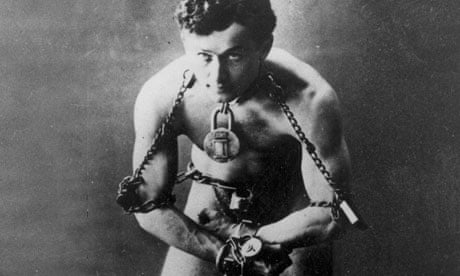Happy birthday, Harry Houdini: you'd have been 137 today (if you hadn't died of a ruptured appendix at 52). But you are not forgotten. Indeed, you're front page on Google and the Twitterocracy are tweeting their greetings even now. The question that inevitably arises is simply: why? Was he more astounding than David Copperfield, more daring than David Blaine, more memorable than Penn and Teller? His real magic is that we shall never know. Apart from a few grimy clips of film a century old, there's no means of judging how or why Houdini became the supreme, enduring icon of escapology and illusion. But it is enough to register that he did. He was the wonder of the world in an old world hungry for wonders.
We must remember the context: American showbusiness in an age long before TV, let alone digital diversions. Houdini's was a time when variety – music hall – ruled, when celebrities came to town for a week, when community meant goggling collectively at the new star acts as they moved from Atlanta to Boston and Cleveland. It was also a time of wild newspaper stunts, such as the attempt by New York World journalist Nellie Bly to try to beat Phileas Fogg's pseudo-record of traversing the world in 80 days.
Houdini (otherwise known as Erik Weisz from Budapest via Wisconsin) captured that zeitgeist precisely. He started out as a routine conjurer, but swiftly realised that audiences needed something to spark their imagination and stir saloon-bar debate. Milk-churn escapes, straitjackets, Chinese water torture cabinets? He could beat them all – even being buried alive. And the selling point wasn't some mock pretence at supernatural power, or the standard tease of stock illusionists thumping hollow cabinets. You were invited to believe in the dangers he apparently faced, to participate in the rippling fear that he might die as the minutes ticked by. His showmanship was based on making you wince and catch your breath, then heave a huge sigh of relief.
He also had real adventures of his own, as an aviator. Houdini wasn't just larger than life, he lived a thrill-packed life to the full. He was the embodiment of something incredible – and, for other professional magicians, proof of a technical ingenuity that can still impress. Even his name, borrowed from the magisterial French magician, Robert Houdin, was a masterstroke. Watch today's "Houdini acts" every time a politician in a jam wriggles free. Short, stocky Erik from Hungary will still be remembered another 137 years on, for he pulled off the greatest trick of the lot: he came to represent the sum of all amazements.

Comments (…)
Sign in or create your Guardian account to join the discussion